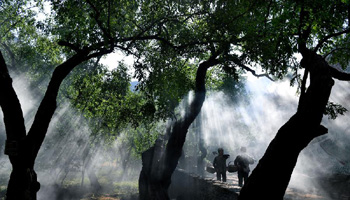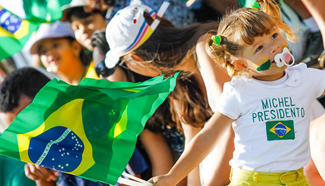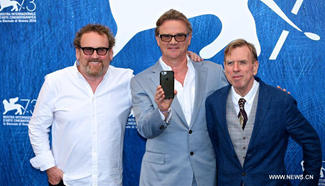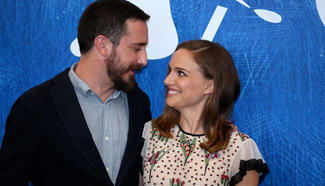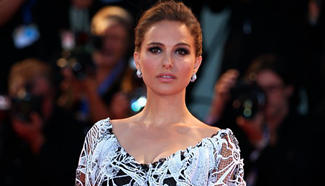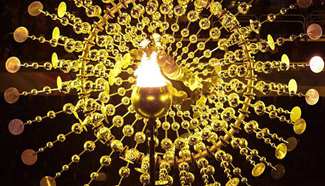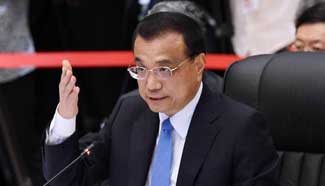By Michael Place
RIO DE JANEIRO, Sept. 7 (Xinhua) -- The Rio Paralympic Games officially opened on Wednesday with a four-hour extravaganza featuring high-octane energy, artistic creativity and touching humanity.
With a central theme of "Everybody has a heart", the opening ceremony's producers promised a show that would "surprise, provoke and celebrate with a Brazilian twist". And they did not disappoint.
Despite wet and windy conditions at the Maracana stadium, a capacity crowd of more than 50,000 attended the show, which was beamed to television viewers in 154 countries and regions.
The ceremony began with a video that showed images of the Paralympic Games' birthplace at Stoke Mandeville before super-imposing Sir Philip Craven, the president of the International Paralympic Committee, on a montage of diverse Brazilian landscapes. Craven, himself a former Paralympic athlete, then appeared in the Maracana stands where he activated a countdown on a large panel.
As the countdown reached its climax, Aaron Wheelz, an extreme wheelchair athlete, hurtled down a 17-meter ramp and executed a stunning reverse somersault while fireworks lit up the skyline. With the tone of the ceremony set, the work of artistic directors Vik Muniz, Fred Gelli, Marcelo Paiva and Paula Mello then subtly delivered the ceremony's central theme.
In a tribute to one of the oldest icons of human ingenuity - the wheel - seven-year-old percussionist Pedrinho da Serrinha entered the stage while playing a solo on the pandeiro, a Brazilian hand-frame drum. A samba circle of artists appeared around him while images projected from above gave the impression that the stage was revolving.
Props were used to create an optical effect of a wheel that transformed into several colorful variations before disappearing to once again make Pedro and his pandeiro the focal point.
No celebration of Rio de Janeiro's culture would be complete without a mention of the city's beaches, an internationally- recognized symbol of Rio's diversity, spontaneity and hospitality.
As Brazilian Paralympic swimmer Daniel Dias dived into crystalline waters, a spectacular sunrise emerged over a golden-sand beach. Cariocas - as Rio residents are known - arrived en masse, with surfers, sunbathers, vendors, sports enthusiasts and people with physical disabilities sharing the same stretch of sand. The beachgoers then broke into song and dance, stopping only to applaud the sunset, a typical Rio ritual.
The spotlight shifted to a large Brazilian flag while pianist Joao Carlos Martins performed Brazil's national anthem. Dozens of beach umbrellas opened up to reveal a giant image of the Brazilian flag.
Spectators' attention then turned to the athletes for their traditional stadium entry and parade. Each team had a placard bearer carrying jigsaw pieces which they assembled one-by-one in the center of the stage.
Unsurprisingly the biggest cheer of the night was reserved for Brazil, the final team to set foot inside the stadium. The hosts' entry meant that the last piece of the puzzle was put in place, revealing an image of a heart which, with the help of special visual effects, began to beat.
After speeches from Rio 2016 organizing committee president Carlos Nuzman and Craven, the Games were officially declared open. The next segments were dedicated to broadening the senses and questioning the predominance of sight by emphasizing the importance of touch, smell, taste and hearing.
The Maracana went into darkness before people carrying light sticks - in a manner reminiscent of the blind carrying canes - made their way across the stage. Meanwhile a huge graphic eye came into view before being deconstructed, conveying the feeling of blindness. An optical illusion, and the use of an equalizer to converge light and sound, enhanced the sense of hearing.
Touch became the main theme when dancers Oscar and Renato came together on a projected tactile floor, revealing their blindness. A synesthesia effect was created by the use of a vertical screen that augmented the tactile experience - transforming the sense of touch into a visual dimension.
A video showed a dancer in poses that reflected Leonardo da Vinci's Vitruvian Man. The scene challenged common perceptions of perfect geometric shape. Moments later a human kaleidoscope was formed, giving the audience the impression that there were hundreds of dancers on stage when in fact there were less than 20.
Most Paralympians would not have reached the elite levels of their sports if not for the support of family and friends. The artistic directors paid tribute to those people by telling their stories of dedication and love.
A short video explained how Alexandre Faleiros created a special boot to allow his disabled son to fulfil his dream of playing football. A group of disabled children then entered the stage wearing the boots, flanked by their parents and friends.
Following the swearing of the oaths, the ceremony entered its penultimate and arguably most touching segment. It was here that the human element of the Paralympic movement was most evident.
Disabled dancer and Paralympic athlete Amy Purdy shared the stage with Kuka, an industrial robot, and both challenged each other to ever-more-difficult dance moves.
The movements become synchronized before Purdy's swing proved too much for the robot to handle. Aware of its limitations, the robot bowed to Purdy's superiority, pointedly conveying the message that no machine can replace human emotion, creativity and spontaneity.
There was one more message before the show was finished. It came when Brazilian Paralympic athlete Clodoaldo Silva carried the torch toward the pyre only to be stymied by an insurmountable staircase.
Gasps reverberated around the Maracana as the audience empathised with Silva while wondering how the pyre would be lit. Then, as if willed on by the crowd, the staircase morphed into a ramp, allowing Silva to make his way to the top and set Rio's Paralympic flame alight.

